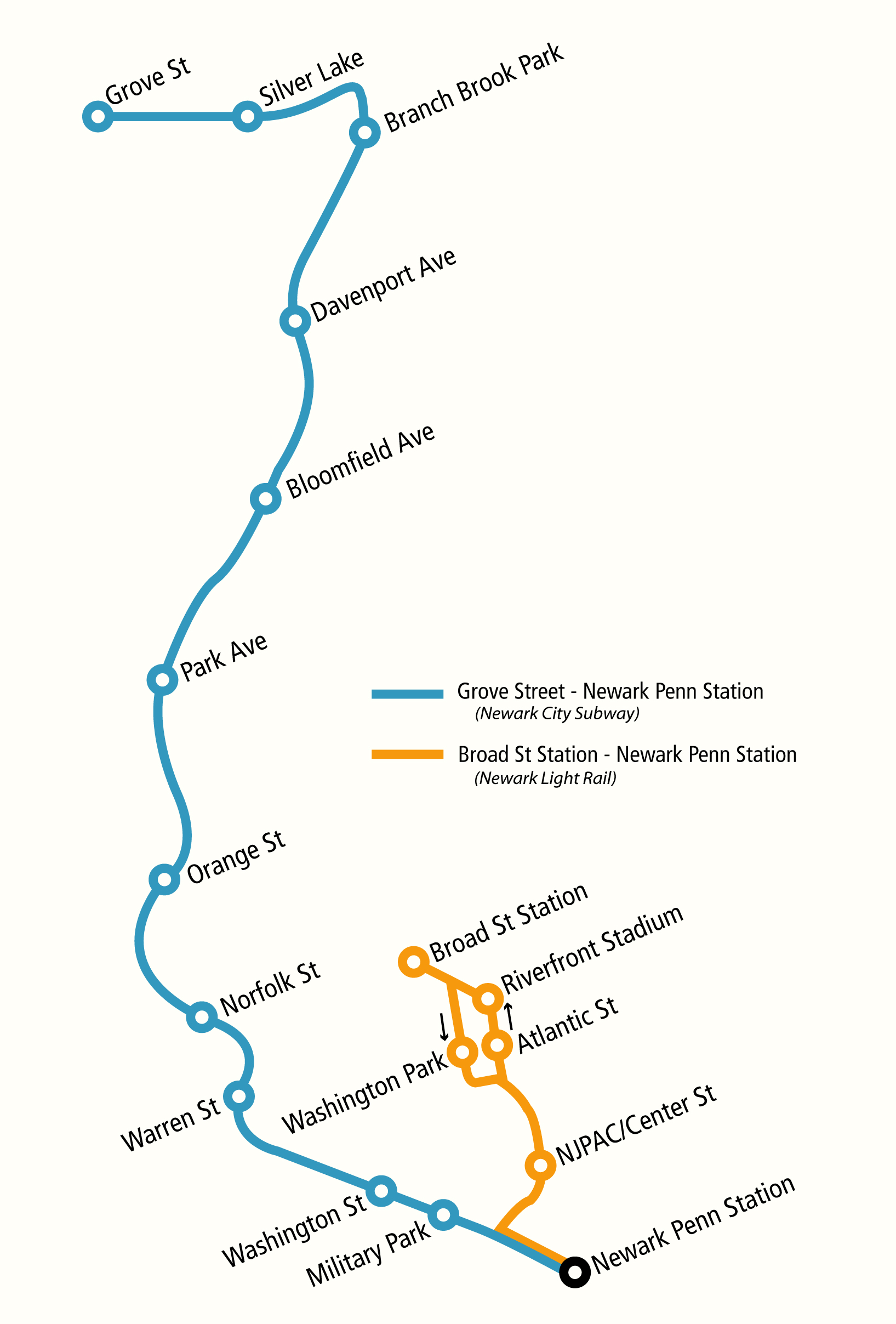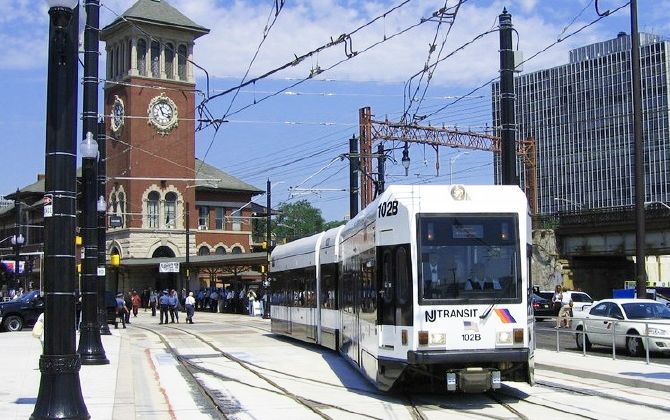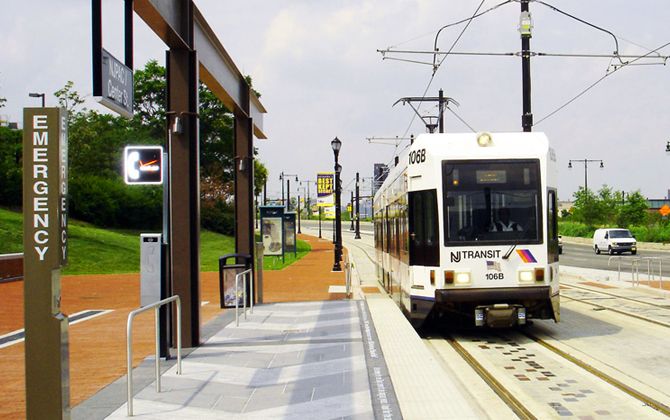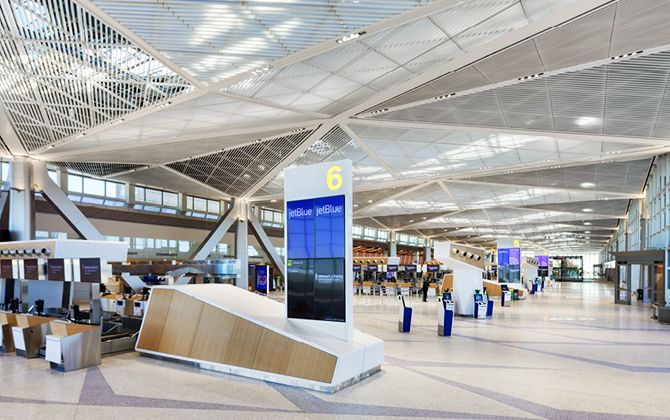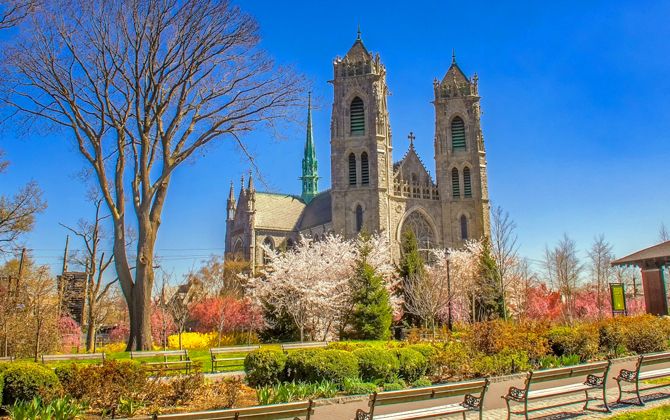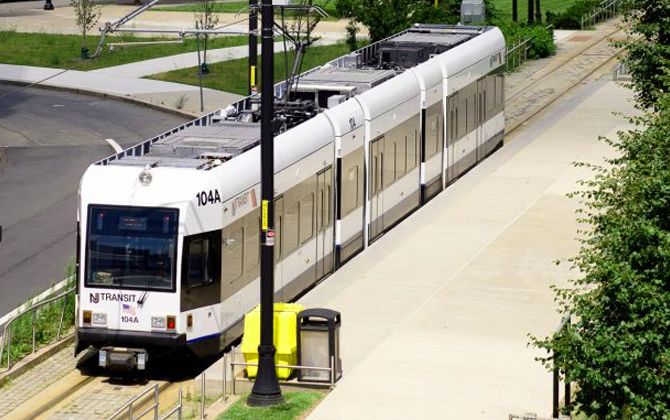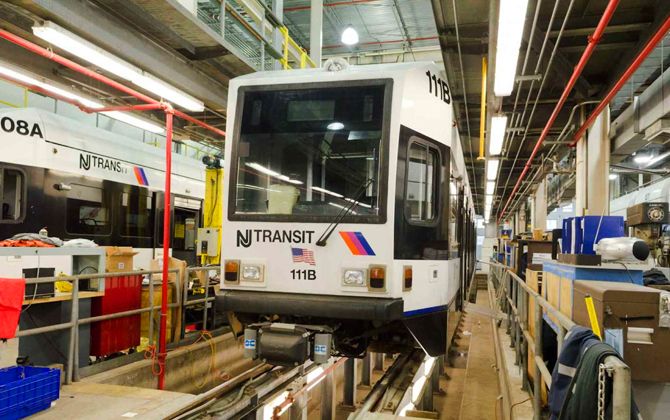The Newark Light Rail (NLR) is a two-line system serving Newark, New Jersey, and nearby communities. It is owned and operated by NJ Transit and includes the original Newark City Subway and the Broad Street Extension.
The City Subway opened in 1935. The Broad Street Extension began service in 2006, when the system was renamed Newark Light Rail. Today it has 17 stations and runs along 10.0 km (6.2 miles) of track. The network connects Newark Penn Station and Newark Broad Street Station, giving riders easy access to downtown Newark, colleges, parks, and residential neighborhoods. Daily ridership reaches tens of thousands. Trains operate about 20 hours a day, seven days a week.
Newark Metro Map
The Newark Light Rail has two main routes: the Newark City Subway and the Broad Street Extension. On maps, these appear as separate branches that meet at Newark Penn Station. The City Subway runs northwest from Penn Station to Grove Street in Bloomfield, with tunnels downtown and surface tracks through Newark and Belleville. The Broad Street Extension runs north from Penn Station to Broad Street Station near the downtown core.
The branches overlap only at Newark Penn Station. On weekdays, they operate separately, requiring a transfer at Penn Station to switch lines. On weekends, a through-service usually runs from Broad Street to Grove Street with no transfer. The full route is just over 10 km (6 miles).
Map of Newark Metro showing different lines. Click on the map to enlarge it or download the Newark Metro map in PDF format.
Lines and Stations
The Newark Light Rail (NLR), operated by NJ Transit, connects with multiple transit modes. At Newark Penn Station, riders can transfer to NJ Transit commuter rail, Amtrak, PATH to Manhattan, and numerous NJ Transit buses. At Broad Street Station, transfers are available to the Morris & Essex and Montclair-Boonton rail lines.
Newark City Subway
The Newark City Subway is the original and longer line of the NLR. It runs 8.5 km (5.3 miles) from Newark Penn Station to Grove Street in Bloomfield, with 12 stations: four underground downtown and eight surface or open-cut. Opened in 1935 in the former Morris Canal bed, the subway features Art Deco murals at underground stations.
Stations south to north:
- Newark Penn Station – Downtown hub and terminus. Connects to Amtrak, NJ Transit rail, PATH, intercity and local buses. Fully accessible.
- Military Park – Underground at Broad St./Raymond Blvd. Near offices, NJPAC, and Prudential Center (5–10 min walk). Strong bus links. Formerly Broad Street Station.
- Washington Street – Underground at Raymond Blvd./University Ave. Near University Heights, Newark Museum, and Harriet Tubman Square. Accessible and heavily used by students.
- Warren Street/NJIT – Underground at Lock St. Serves NJIT and Rutgers medical school. Last underground stop. Campus shuttles connect here.
- Norfolk Street – Open-cut near Central Ave. Serves Rutgers area. Not accessible. Buses 24, 44, 99.
- Orange Street – Surface stop near I-280. Accessible island platform. Adjacent to Branch Brook Park. Buses 29, 71, 73.
- Park Avenue – Below-grade at Park Ave./N. 4th St. Serves Forest Hill. Not accessible. Bus 41 nearby.
- Bloomfield Avenue – Accessible open-cut stop at Bloomfield Ave. Major bus transfer (11, 28, 29, Go28). Popular for Branch Brook Park cherry blossom visitors.
- Davenport Avenue – Small at-grade stop.
- Branch Brook Park – Built 2002, replacing Franklin Ave and Heller Pkwy. Park-and-ride with bus loop and 112 spaces. Accessible. Buses 27, 74, 90, 92, 99.
- Silver Lake – Surface stop in Belleville, opened 2002. Accessible. Buses 27, 90.
- Grove Street – Northern terminus in Bloomfield, opened 2002. Accessible with 160 parking spaces. Bus routes 11, 28, Go28, 29, 72, 90. Near Garden State Parkway Exit (0.8 km / 0.5 mi).
Broad Street Extension
Opened in 2006, this 1.6 km (1 mile) line connects Penn Station with Broad Street Station, uniting Newark’s two main rail hubs. Northbound and southbound trains use separate streets before merging near Broad Street Station. The extension has five stops, two one-directional.
- Newark Penn Station – Shared terminus with City Subway. Transfers to PATH, Amtrak, NJ Transit rail, and buses.
- NJPAC/Center Street – Near NJPAC and downtown offices. Open-air, with public art. Close to many bus routes.
- Harriet Tubman Square – Southbound-only at Broad St./Bridge St. Accessible. Near Newark Museum and Library. Served by major bus routes.
- Atlantic Street – Northbound-only near Broad St. One side platform. Serves Riverfront Square area. Bus service similar to Harriet Tubman Square.
- Riverfront Stadium – Northbound stop near former stadium site, now Riverfront Square. Simple platform with bus connections.
- Newark Broad Street Station – Northern terminus. Major commuter rail hub. Fully accessible, with extensive bus service (11, 13, 27, 28, Go28, 29, 30, 41, 71, 72, 73, 76, 78, 108, 378). Go28 provides direct service to Newark Liberty Airport.
Fares and Prices
Newark Light Rail fares are simple and low-cost. A one-way ticket across the system costs $1.80 (USD 1.80 / 1.80 USD) as of July 2024. This price matches a one-zone NJ Transit bus fare. Tickets are valid for 60 minutes after validation, allowing free transfers between NLR trains during that time.
Tickets and Passes
| Ticket Type | Price |
|---|---|
| One-Way (Adult, entire NLR) | $1.80 (USD 1.80) |
| One-Way “Underground Only” (downtown stations) | $0.85 (USD 0.85) |
| One-Way Senior / Disabled / Youth (ages 5–11) | $0.85 (USD 0.85) |
| Monthly Pass (Unlimited NLR rides) | $67.00 (USD 67.00) |
A monthly pass offers unlimited rides on Newark Light Rail for a calendar month, priced at about 37 times the one-way fare (around $67). NJ Transit bus or rail monthly passes (with at least one zone) are also valid on the light rail. Bus transfer tickets can be used on the light rail within their 2-hour validity.
Purchasing & Validation
Ticket vending machines are at every station and accept cash, credit, debit, and mobile payments via the NJ Transit app. Paper tickets must be validated in a machine on the platform, which stamps the current time. Mobile tickets must be activated before boarding. Once validated, tickets remain valid for 60 minutes, including transfers between the two branches.
Schedule
The Newark Light Rail runs daily from about 5:00 AM until 1:00 AM. The first weekday train leaves Grove Street around 4:55 AM, and the last train leaves Penn Station near 12:35 AM. Hours on the Broad Street branch are similar.
Trains are frequent during rush hours: every 5–7 minutes on the City Subway and about every 10 minutes on the Broad Street Extension. Midday and evening service is every 15–20 minutes, and late evenings after 9:00 PM about every 20–30 minutes. On weekends, trains generally run every 20 minutes on a through-route from Broad Street to Grove Street.
Service patterns differ by day. On weekdays, the two branches run separately, with transfers at Penn Station. On weekends, a single line runs directly from Broad Street through Penn to Grove Street, with no transfer needed.
Connection to the Airport
The Newark Light Rail does not go directly to Newark Liberty International Airport (EWR), but connections are simple. You can reach the airport from either Newark Broad Street Station or Newark Penn Station.
From Newark Broad Street Station
The Go28 express bus runs directly from Broad Street Station to all EWR terminals (A, B, C). It departs from the bus area at Location B. Buses run every 15–20 minutes on weekdays and every 20–30 minutes on weekends. The trip takes 25–30 minutes. The fare is $1.80 (USD 1.80), or free with a valid monthly pass that includes bus privileges.
From Newark Penn Station
NJ Transit Rail + AirTrain: Take an NJ Transit commuter train (Northeast Corridor or North Jersey Coast Line) from Penn to Newark Liberty Airport Station. The ride is 8 minutes. From there, transfer to the AirTrain monorail to reach your terminal. A combined NJT + AirTrain ticket costs about $15 (USD 15.00). Total travel time: 15 minutes.
NJ Transit Bus 62: The #62 bus runs 24/7 from Penn Station to all airport terminals. Daytime frequency is every 20 minutes, late nights about every 30 minutes. Travel time is ~25 minutes. The fare is $1.80 (USD 1.80). This is the cheapest option but subject to traffic.
Rules
Newark Light Rail has established rules to ensure passenger safety, comfort and the smooth running of the service. These include
- Dispose of litter responsibly and not on the tracks.
- Use caution when picking up items that have fallen on the tracks.
- Children under the age of five travel free when accompanied by a parent or guardian.
- Hold hands with young children or anyone else in your care to prevent accidents.
- Do not board trains until they have come to a complete stop.
- Wait behind the yellow line until the train has stopped and the doors have opened.
- Smoking is prohibited on Newark Light Rail trains.
- The use or transportation of narcotics, hallucinogens or other illegal substances is prohibited.
- Passengers may not be under the influence of alcohol or hallucinogenic substances.
- No running in stations or on trains.
- Be aware of the difference in height between the train and the platform to avoid falls.
- Pushchairs must be folded before boarding the train.
- Do not leave luggage, bags or rucksacks unattended.
- If you notice unattended luggage, report it immediately to the authorities.
- The carriage of flammable objects, fireworks or other dangerous materials is prohibited.
- No eating on trains.
Fun Facts
Roots as a Historic Trolley Subway. The Newark Light Rail’s City Subway is one of the oldest electric transit lines in the U.S., opened May 26, 1935, as the #7 line. It was built in the old Morris Canal bed, with tunnels decorated by WPA Art Deco murals. Some mosaics can still be seen at Washington Street and Military Park stations.
The PCC Era. The subway ran PCC streetcars from 1954 until 2001, the last in the U.S. outside San Francisco. Car #5 is preserved at the Seashore Trolley Museum in Maine. Today, the line runs modern Kinki Sharyo light rail vehicles.
City Subway Ghosts – Abandoned Stations. Heller Parkway closed in 2002 when Branch Brook Park station opened; its entrance remains. Franklin Avenue, once the terminus, was also replaced. A sealed junction still exists near Penn Station where the Cedar Street spur once connected to the long-demolished Public Service Terminal.
“Newark-Elizabeth Rail Link” Plan. The 2006 Broad Street Extension was Phase 1 of a larger plan to reach Elizabeth via Newark Airport. Phases 2 and 3, south to the airport and then Elizabeth, were studied in the early 2000s but never built. As of 2026, no work has begun, though the idea remains in regional plans.
Movie Cameo. In 2011, The Dark Knight Rises filmed scenes at Military Park Station, which stood in as Gotham’s subway.
Tributes in Station Art. The 2006 extension added public art celebrating Newark’s jazz heritage, with mosaics and Sarah Vaughan tributes. Harriet Tubman Square station features works by local artist Willie Cole. Older stations retain vintage tile signs, like “Plane St” at Washington Street.
Nation’s Largest Cherry Blossom Festival. Branch Brook Park, served by several stations, has the largest cherry blossom collection in the U.S., surpassing Washington, D.C. Each April, its festival draws thousands, with NJ Transit adding extra service during peak bloom.
Ridership and Operations. Weekday ridership grew from about 9,000 in 2010 to over 20,000 by the late 2010s, before dropping during the pandemic. The system uses 20 cars, usually single-car trains but with two-car capacity. A short section near Branch Brook Park is still shared with Norfolk Southern freight at night.
Tourist Attractions
The Newark Light Rail isn’t just for commuters or students. It’s also a convenient way for tourists to reach Newark’s cultural and historic landmarks. Here are some key attractions accessible from NLR stations:
- Branch Brook Park
(Accessible from Branch Brook Park, Bloomfield Ave, Park Ave, or Orange St stations.) This 360-acre (145-hectare) park is known for its cherry blossoms, lakes, and historic bridges. Each spring, the Cherry Blossom Festival showcases more than 5,000 trees—the largest collection in the U.S.
- Downtown Arts and Entertainment
NJPAC (New Jersey Performing Arts Center) is next to NJPAC/Center Street Station on the Broad Street Extension. It hosts concerts, Broadway shows, and cultural events. A short walk from NJPAC is Military Park, a historic green space with statues and food truck gatherings.
Two blocks from Military Park Station is the Prudential Center, home to the NHL’s New Jersey Devils and major concerts. It’s a 7-minute walk (about 0.6 km / 0.4 mi) south of Military Park Station or a 5-minute walk (about 0.4 km / 0.25 mi) from Penn Station.
Art lovers should stop at the Newark Museum of Art, New Jersey’s largest museum, near Washington Street/Harriet Tubman Sq Station (a 3-minute walk).
- University Heights and Science
Warren Street/NJIT and Norfolk Street stations are in University Heights, home to NJIT, Rutgers-Newark, Essex County College, and Rutgers Biomedical. While not typical tourist stops, the area includes NJIT’s observatory (open for public stargazing) and campus galleries. It’s also ideal for prospective students on campus tours.
- Historic Architecture
Newark’s history is visible along the line. Near Washington Street Station stands the 1907 Essex County Courthouse and the Veterans Courthouse. Harriet Tubman Square is surrounded by historic churches like St. Patrick’s Pro-Cathedral and Beaux-Arts buildings.
Broad Street Station, the northern terminus, is a 1903 neo-classical train station worth visiting for its interior waiting room and restored Lackawanna Railroad signage. The Broad Street Historic District also includes the old Morris Canal lock near Division Street and redeveloped factory buildings.
- Sports and Minor League Nostalgia
Riverfront Stadium Station once served the Newark Bears baseball team. The stadium has since been demolished, and the site is now being redeveloped as Riverfront Square. Sports fans may enjoy seeing how the space is transforming. For live sports, the Prudential Center is nearby, and Red Bull Arena (soccer) is accessible via PATH from Penn Station.
- Food and Culture
Newark’s Ironbound district is famous for Portuguese and Brazilian food. From Penn Station, walk east along Ferry Street about 5–10 minutes (0.8–1.6 km / 0.5–1 mi) to reach the neighborhood’s restaurants, bakeries, and shops.
Near Orange Street Station in Forest Hill, you’ll find the Stephen Crane House (the author’s birthplace) and local eateries. From Bloomfield’s Grove Street Station, a short bus ride or walk takes you to Bloomfield Center, a small downtown with dining and shopping.
Connections
One of Newark Light Rail’s strengths is seamless integration with other transit. Nearly every station connects to NJ Transit buses, and the terminals link to heavy rail.
Newark City Subway – Station Connections
Newark Penn Station: Major intercity and regional hub. Rail: NJ Transit (Northeast Corridor, North Jersey Coast, Raritan Valley) and Amtrak (Northeast Corridor). Rapid transit: PATH to Jersey City and World Trade Center. Buses (NJT): 1, 5, 11, 21, 25, GO25, 28, 29, 30, 31, 34, 39, 40, 41, 44, 62, 65, 66, 67, 70, 71, 72, 73, 76, 78, 79, 108, plus regional coaches. Greyhound and private shuttles (e.g., Rutgers) also serve Penn. If a bus runs in Newark, it likely stops here.
Military Park: Downtown, a block or two from Broad St and Market St stops. Buses (NJT): 11, 13, 27, 28, GO28, 29, 30, 39, 40, 41, 59, 62, 65, 66, 71, 72, 73, 78, 79, 108, 378. Contracted ONE Bus: 24, 44. Quick transfers to Newark Airport (go28 or 62), Irvington (39, 24), the Oranges (21, 71), and Jersey City (1; 119 a few blocks away).
Washington Street (Harriet Tubman Square area): Near Broad St & Washington Park with north–south service on Broad and east–west on Raymond/Lombardy. Buses (NJT): 11, 28, 29, 30, 41, 70, 71, 72, 73, 76, 78, 79. go28 is one block away on Broad. Short walk to 13 and 27 stops nearby.
Warren Street/NJIT: Along Lock St by MLK Jr. Blvd in University Heights. Buses (NJT): 71, 73, 79 on MLK by NJIT/ECC. Campus shuttles (Rutgers, NJIT) stop on Warren or Lock (not NJT routes).
Norfolk Street: At Norfolk St & Central Ave. Buses: 24, 44 (ONE Bus on Central Ave), 99 (NJT) on Central. A short walk south to Springfield Ave for 34 or 31.
Orange Street: Stops on Orange St. Buses (NJT): 29, 71, 73. (21 runs on the nearby I-280 overpass; reachable via a short walk to First St.)
Park Avenue: Station is in a cut; stops up on Park Ave. Bus (NJT): 41 serves Park Ave & 4th St. The 74 is a few blocks east (closer to Branch Brook Park Station).
Bloomfield Avenue: On Bloomfield Ave, a key corridor and transfer point. Buses (NJT): 11, 28, GO28, 29, 72 stop at/near the station. Designed for easy rail–bus transfers along Bloomfield Ave.
Davenport Avenue: No routes on Davenport itself. Walk 2–3 blocks to reach lines on Park Ave (41, 74), Mount Prospect Ave (27), or Bloomfield Ave (13). Primarily a local stop.
Branch Brook Park: Major intermodal stop with a bus loop. Buses (NJT): 27, 74, 90, 92, 99 enter the station area for direct platform transfers. Nearby on Franklin/Lake: access to 11 and 28.
Silver Lake: Near Franklin/Washington Ave in Belleville. Buses (NJT): 27 (Franklin Ave) and 90 (Washington Ave). (Historical note: DeCamp 44 to NYC was suspended; not NJT.)
Grove Street: Bloomfield terminus with bus loop and park-and-ride. Buses (NJT): 11, 28, GO28, 29, 72, 90 at/adjacent to the station. go28 terminates here, linking EWR via downtown Newark. One block away: Bloomfield rail station (Montclair-Boonton Line) is about a 7-minute walk on Bloomfield Ave.
Broad Street Extension – Station Connections
Newark Penn Station: See City Subway entry above. Same rail (Amtrak, NJ Transit, PATH) and bus connections; Broad Street Extension trains share the Penn platforms with City Subway trains.
NJPAC/Center Street: No stop on Center St itself, but Broad St and McCarter Hwy (Rte 21) stops are 1–2 minutes away on foot. Use Harriet Tubman Square or Atlantic St stops for bus connections (~150 m / ~500 ft). Nearby buses (NJT): 11, 13, 27, 28, GO28, 29, 30, 41, 76, 78, 108, 378.
Harriet Tubman Square (southbound only): Surrounded by stops on Broad, Washington, and Rector. Buses (NJT): 1, 11, 13, 27, 28, GO28, 29, 30, 41, 59, 76, 378. Quick access to #1 (Washington St to Jersey City), 13 (Clinton Ave), and 59 (south toward New Brunswick), plus core Broad St routes.
Atlantic Street (northbound only): Same area as Tubman Sq but for northbound trains. Buses (NJT): 11, 13, 27, 28, GO28, 29, 30, 41, 76, 378. Many riders stay on to Broad Street Station for sheltered transfers.
Riverfront Stadium (northbound only): One block from Broad Street Station; connections nearly identical. Buses (NJT): 11, 13, 27, 28, GO28, 29, 30, 41, 76, 378. Useful for events or stops slightly south of Broad Street Station.
Newark Broad Street Station: Major bus and rail interchange. Buses (NJT): 11, 13, 27, 28, GO28, 29, 30, 41, 71, 72, 73, 76, 78, 108, 378. Stops line Broad St and Lackawanna Ave (designated A/B/C bays). Rail: NJ Transit Morris & Essex Lines to Hoboken, Secaucus, and New York Penn. Many riders use the light rail to shuttle between Broad Street Station and Penn Station.
In practice, almost every NLR station has bus links. Downtown stops (Penn, Military Park/Washington) offer the densest network. Neighborhood stations (Warren, Norfolk, Orange, Park, etc.) provide corridor coverage. Hubs like Branch Brook Park, Grove Street, and Broad Street concentrate multiple lines for easy transfers. NJ Transit fare products cover bus and light rail, making NLR a seamless part of regional travel.
History
Planning and Construction: The idea for a subway in Newark dates to 1910. Construction of the #7 City Subway began in 1929 along the former Morris Canal under Raymond Boulevard. The first section opened October 3, 1934, from Broad Street to Heller Parkway. Service extended to the new Penn Station on June 20, 1937, with WPA support to reduce street-level congestion.
Early Operations: Originally, several streetcar lines fed into the subway via ramps at Warren, Norfolk, and Bloomfield. By the 1950s, surface lines were converted to buses, leaving only the #7 route. By 1953, the subway became a self-contained line from Penn Station to Franklin Ave/Heller Parkway. PCC streetcars entered service in 1954. NJ Transit assumed operations in 1980.
Extensions and Modifications: In 1940, the line extended to Franklin Avenue in Belleville, remaining the terminus until 2002. A short spur once connected to the Public Service Terminal but closed in 1937. The subway survived while most U.S. streetcars disappeared, thanks to its grade separation and low costs. NJ Transit formally took over in 1980.
Modernization – New LRVs: By the 1990s, infrastructure and PCC cars were worn out. NJ Transit ordered new Kinki Sharyo vehicles. The PCCs made their last run on August 24, 2001. Modern LRVs entered service August 27, 2001, marking the shift to light rail. In 2014, some cars were lengthened to increase capacity.
2002 Extension to Grove Street: Phase 1A of the Newark–Elizabeth Rail Link extended service beyond Franklin Ave. On June 22, 2002, Silver Lake and Grove Street stations opened. Franklin Ave and Heller Parkway stops closed, replaced by the new Branch Brook Park intermodal station. The extension, about 1 mile (1.6 km), used the old Erie Railroad Orange Branch and brought the line to 5.3 miles (8.5 km).
2006 Broad Street Extension: Phase 1B created a 1-mile (1.6 km) spur from Penn Station to Broad Street Station, opening July 17, 2006. It added NJPAC/Center Street and Broad Street stations, plus Harriet Tubman Square and Atlantic Street. Costing about $207.7 million, it cut transfers between Newark’s two main stations to a 10-minute ride. NJ Transit rebranded the system “Newark Light Rail.” The extension spurred ridership and development.
Post-2006 and Future: Since 2006, no new extensions have been built. Proposals include extending to Newark Liberty Airport, a short extension toward the riverfront, or even linking with Hudson-Bergen Light Rail—though none are active projects. The NewBus Newark initiative is redesigning bus routes to better feed into light rail. NJ Transit may acquire more LRVs if needed.
